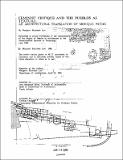| dc.contributor.advisor | John Randolph Myer. | en_US |
| dc.contributor.author | Lew, Margaret Elizabeth | en_US |
| dc.contributor.other | Massachusetts Institute of Technology. Dept. of Architecture. | en_US |
| dc.date.accessioned | 2013-01-07T21:10:43Z | |
| dc.date.available | 2013-01-07T21:10:43Z | |
| dc.date.copyright | 1986 | en_US |
| dc.date.issued | 1986 | en_US |
| dc.identifier.uri | http://hdl.handle.net/1721.1/75979 | |
| dc.description | Thesis (M. Arch.)--Massachusetts Institute of Technology, Dept. of Architecture, 1986. | en_US |
| dc.description | MICROFICHE COPY AVAILABLE IN ARCHIVES AND ROTCH | en_US |
| dc.description | Includes bibliographical references (p. 118-121). | en_US |
| dc.description.abstract | This thesis poses the question of a feminist architecture that is not based on 'women' per say - their involvement as architects, their difference, or as users - but on the possibilities 1), of the world as perceived, described, invented in feminist theory, and of the facts 2), of the spatial and building systems created by Pueblo women. I have looked to feminist research and critical theory, first, to expand its critique of gender, (as a cultural not a biological construct), to include architecture; secondly, to find suggestions and characteristics of alternative constructions. The pueblos provide an architectural text, an example of the kinds of places women make when they are the ones to shape the built environment. Both address in their respective ways questions about the relationship between public and private, between 'units', and how boundaries are characterized and transgressed. Drawing on both, I make a schematic design that suggests the architectural qualities that could result from these principles. The thesis follows in principle one general feminist methodology: The 'peeling away of the layers' of cultural assumption and determinism through the analysis of remains, remnants, and fragments whether archaeological, linguistic, etc.; Finally, the critique becomes invention and transformation. The task is to find in theory (feminist); artifact (the pueblos); and experiment (the fictional writing of Wittig) - themes, elements, and attitudes which can have spatial, perceptual, and, thus, architectural significance. A portion of the thesis rests on what I have construed to be some aspects of feminisms' affinity with the complex structuring and observational methods of Maurice Smith's form language and with the spirit of user participation and intervention in John Habraken's thematic design methodology. My assumption is that feminism can help expand and enrich the theoretical foundation of that work. And vice versa - that it can introduce theories of form and organization into the feminist critique of architecture. | en_US |
| dc.description.statementofresponsibility | by Margaret Elizabeth Lew. | en_US |
| dc.format.extent | 129 p. (some folded) | en_US |
| dc.language.iso | eng | en_US |
| dc.publisher | Massachusetts Institute of Technology | en_US |
| dc.rights | M.I.T. theses are protected by
copyright. They may be viewed from this source for any purpose, but
reproduction or distribution in any format is prohibited without written
permission. See provided URL for inquiries about permission. | en_US |
| dc.rights.uri | http://dspace.mit.edu/handle/1721.1/7582 | en_US |
| dc.subject | Architecture. | en_US |
| dc.title | Feminist critique and the Pueblos as textual : an architectural translation of Monique Wittig | en_US |
| dc.title.alternative | Architectural translation of Monique Wittig | en_US |
| dc.type | Thesis | en_US |
| dc.description.degree | M.Arch. | en_US |
| dc.contributor.department | Massachusetts Institute of Technology. Department of Architecture | |
| dc.identifier.oclc | 15434947 | en_US |
